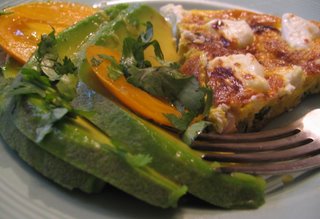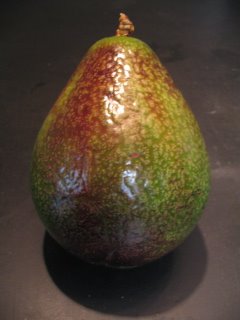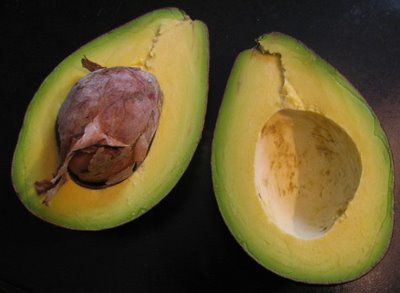Avocado Ecstasy

A few days ago the snub-nosed white FedEx truck squealed to a halt outside our house and delivered a dented and sagging brown cardboard box. It was from Florida. Cross-legged on the floor beside it, B and I dug in, ripping off packing tape and scrabbling like two raccoons through the scrunched up newspaper inside. Nested in that box were twelve or thirteen mammoth fruits that looked like they had been delivered from another solar system. Avocados. But unlike any avocado I have ever seen before. Shaped like tear-drops with full, plump underbellies, they were each a good 7 or 8 inches long. We know this because I ran to the kitchen and got my fridge-magnet-tape-measure off the fridge to verify the data. Popped onto the scales, they each weighed in at a mighty 2 pounds and more. Glossy and green, with a russet blush, they made me remember that I grew up calling their smaller black cousins “avocado pears.” I had not realised that I had shed “pear” from my vocabulary during my sojourn in this country, but one glance at these fulsome fruits recalled the term I had sloughed off.
 This outlandish bounty was sent to us by B’s brother who has recently moved to Florida. His new house has several avocado trees in its garden, and he knew that we would revel in his harvest. I have often fantasised about signing up for those services that deliver you perfect, seasonal, hand-selected fruits through the post. So it is quite dreamy to have ones very own brother-in-law provide it from his very own avocado trees. B was also delighted, but less amazed. Her older brother has always been an ace gift giver. She reminded me that it was Paul who first encouraged her to apprentice herself to the culinary arts. Her college graduation present from him was a beautiful Wusthof chef’s knife that still slices and dices in our kitchen, a bag of Arborio rice, a package of dried porcinis, and a risotto cookbook.
This outlandish bounty was sent to us by B’s brother who has recently moved to Florida. His new house has several avocado trees in its garden, and he knew that we would revel in his harvest. I have often fantasised about signing up for those services that deliver you perfect, seasonal, hand-selected fruits through the post. So it is quite dreamy to have ones very own brother-in-law provide it from his very own avocado trees. B was also delighted, but less amazed. Her older brother has always been an ace gift giver. She reminded me that it was Paul who first encouraged her to apprentice herself to the culinary arts. Her college graduation present from him was a beautiful Wusthof chef’s knife that still slices and dices in our kitchen, a bag of Arborio rice, a package of dried porcinis, and a risotto cookbook. It turns out that avocados, like many other delightful veggies, are a New World comestible. They come in three regional varieties: Mexican, Guatemalan, and Caribbean. The Hass avocado, the little black nubbly one that most of us know best, is a variant of the Mexican strain, which are small and rich and oily, tasting slightly of toasted almonds. The huge Caribbean avocados that Paul sent us are not so unctuous, and have a clear, glassy taste. Because they are less buttery, they don’t take so well to mashing, so no guacamole. They slice, however, into elegant cross-sections, watery beads appearing on their surface, and each slice shades from lime green to a slightly sullen yellow.
 The flavour is more subtle, and lighter on the tongue than the Mexican avocado, but exquisitely delicious. I realised, as I let the first bite fill my mouth with that salady taste, that I had purchased a Caribbean avocado before. But that shop-bought one was depressingly watery, so I had reverted immediately to the Hass hegemony. The wateriness of Paul’s freshly FedExed fruits, however, was refreshing, the taste almost translucent. B and I piled the enormous avocados into our capacious enamel washbasin and spent the week sharing an avocado a day, in variations on the simple salad. We watched the skins turn more and more russet and tasted the flesh become more and more perfect. Guests who dropped by our house left, happy paleontologists, carrying large reptilian eggs.
The flavour is more subtle, and lighter on the tongue than the Mexican avocado, but exquisitely delicious. I realised, as I let the first bite fill my mouth with that salady taste, that I had purchased a Caribbean avocado before. But that shop-bought one was depressingly watery, so I had reverted immediately to the Hass hegemony. The wateriness of Paul’s freshly FedExed fruits, however, was refreshing, the taste almost translucent. B and I piled the enormous avocados into our capacious enamel washbasin and spent the week sharing an avocado a day, in variations on the simple salad. We watched the skins turn more and more russet and tasted the flesh become more and more perfect. Guests who dropped by our house left, happy paleontologists, carrying large reptilian eggs.The avocado not only looks prehistoric, but may indeed be so. Many experts believe that avocado trees were on the earth, at least in what we now call California, about 50 million years ago and that avocados were savoured by dinosaurs, who popped them into their gullets like boiled sweets, assuring avocado propagation by subsequently depositing the large pits from their other ends. The Lords of the Earth, it turns out, were little more than lumbering, gastric potato planters.
And if dinosaurs pooped them out, the association of the avocado pear with the nether regions has only continued. The English word “avocado” is a corruption of a Nahuatl word, “ahuacatl,” meaning “Testicle Tree.” Which is where my almost-forgotten addition of “pear” to “avocado” comes roaring back; pears in general enjoy this saucy equivalency. “The Merchant’s Tale,” one of Chaucer’s Canterbury Tales, features some very impressive pear tree “swyving.”
 In it, a lovely virgin named May is betrothed to a elderly knight named January who up to that point had simply “folwed ay his bodily delyt / On wommen, ther as was his appetyt.” He starts to get a little nervous that all this out-of-wedlock fun and games is not good for his soul, and given that he’s pretty much at death’s door, he thinks that marrying a virtuous lassie will be just the ticket for eleventh hour salvation. But his graduation from hussies to vernal virgins doesn’t go so well. One of January’s attendants, Damian, takes a fancy to young May and wastes away for the love of her. January, who is quite partial to handsome Damian, sends May to sit by Damian’s sick-bed and tend to him. While May and the not-so-sick-after-all Damian pass love notes, January is suddenly stricken blind. His blindness makes him stick tight to May, but despite this she manages to slip Damian a wax impression of a key to January’s secret garden, and signals to Damian to break and enter and climb the pear tree.
In it, a lovely virgin named May is betrothed to a elderly knight named January who up to that point had simply “folwed ay his bodily delyt / On wommen, ther as was his appetyt.” He starts to get a little nervous that all this out-of-wedlock fun and games is not good for his soul, and given that he’s pretty much at death’s door, he thinks that marrying a virtuous lassie will be just the ticket for eleventh hour salvation. But his graduation from hussies to vernal virgins doesn’t go so well. One of January’s attendants, Damian, takes a fancy to young May and wastes away for the love of her. January, who is quite partial to handsome Damian, sends May to sit by Damian’s sick-bed and tend to him. While May and the not-so-sick-after-all Damian pass love notes, January is suddenly stricken blind. His blindness makes him stick tight to May, but despite this she manages to slip Damian a wax impression of a key to January’s secret garden, and signals to Damian to break and enter and climb the pear tree. May then leads January to the pear tree and pretends that she has an insatiable lust for one of the small green fruits. She tells her old, blind husband to bend over to let her climb up on his back. Sporting a smock, she clambers into the tree “That charged was with fruyt,” where “Damian/Gan pullen up the smok, an in he throng.” Goodness gracious me. Lust for pears and lust for Damian’s throngings, my blushing high-school English teacher managed to convey, become one and the same through the – “underline it, girls!” – “SYMBOLISM of the pear.”
I feel she needn’t have waggled her eyebrows so hard to convey what the pear can symbolise if only she had invoked the avocado pear instead. We were a classroom of, now I come to think of it, yellow and green uniformed girls, all of us born in the early seventies.
 We knew that the slick flesh of an avocado pear was intimately connected to our parents’ sense of themselves as the Joy of Sex Generation. The Joy of Sex, a naughty riff on The Joy of Cooking, and later subtitled A Gourmet Guide to Lovemaking, was first published in the year of my birth. It is organised like a menu with "Sauces and Pickles" and "Main Courses." I am, simply, proud to share my nativity with a book that sutures defiantly hairy sex and food in this way. As a teenager, I would only accept baby-sitting gigs at houses that I knew had this text crammed under the bedside table. I can't recall if avocados were featured specifically, but stuffed with nakedly pink prawns, and draped in cocktail sauce, the halved avocado pear was for me the essence of sultry 70s sophistication. It was served by other people's mothers who sashayed in kaftans or lounge suits across smoky rooms hung with bamboo wallpaper. That was an era that championed the wearing of satin pyjamas to dinner parties, an era that called that avocado-prawn dish a “cocktail,” and I longed to join the fun. Those days are gone. The Joy of Sex is now depilated beyond all recognition, nobody smokes anymore and only my students seem to wear - rumpled cotton - pyjamas in public. But perhaps the avocado pear can smuggle to us (as through the belly of a dinosaur) the seed of more glam times.
We knew that the slick flesh of an avocado pear was intimately connected to our parents’ sense of themselves as the Joy of Sex Generation. The Joy of Sex, a naughty riff on The Joy of Cooking, and later subtitled A Gourmet Guide to Lovemaking, was first published in the year of my birth. It is organised like a menu with "Sauces and Pickles" and "Main Courses." I am, simply, proud to share my nativity with a book that sutures defiantly hairy sex and food in this way. As a teenager, I would only accept baby-sitting gigs at houses that I knew had this text crammed under the bedside table. I can't recall if avocados were featured specifically, but stuffed with nakedly pink prawns, and draped in cocktail sauce, the halved avocado pear was for me the essence of sultry 70s sophistication. It was served by other people's mothers who sashayed in kaftans or lounge suits across smoky rooms hung with bamboo wallpaper. That was an era that championed the wearing of satin pyjamas to dinner parties, an era that called that avocado-prawn dish a “cocktail,” and I longed to join the fun. Those days are gone. The Joy of Sex is now depilated beyond all recognition, nobody smokes anymore and only my students seem to wear - rumpled cotton - pyjamas in public. But perhaps the avocado pear can smuggle to us (as through the belly of a dinosaur) the seed of more glam times. 
6 Comments:
wow! what a post. I too have been avocado ecstasy for the past month because there are some great ones in season right now here in CA. I have been meaning to do a comparative taste test between three locally grown varieties - Gwen - Hess - Bacon but haven't gotten round to it yet. There is no way I could ever top all those saucy chaucer tales.
Yay -- another post! I was afraid that the beginning of the academic year had meant the end of Syllabub.
Alligator pears is what women of my granny's generation called avocados. I always assumed the alligator was invoked because of the similarity of its skin to the aquatic reptiles's raspy hide, but according to the American Heritage dictionary, the tree was said to have flourished the same swamps the alligatoe favored. The same source says that "avocado" is first recorded in English in 1697 as "avogato pear," but this story on the NPR Web site attributes the widespread adoption of the word in the United States to a marketing campaign by California growers in the early 20th century.
In 1984, I offered shelter for a couple of days to a pair of wandering street preachers who called themselves "A-men." They wore white robes and went barefoot like mendicant friars, and they were strict vegans, the first I'd ever met, although I don't remember them using the word "vegan." So they didn't eat ice cream, but they did have a rich, creamy frozen dessert -- it was made of mashed-up avocados and sugar. They called it a nuclear freeze.
Let me second the "Phew! I thought she
wasn't going to blog again, just after
I found this amazingly wonderful site!"
Now that I've said that, it's time to
read the entry:-)
Proust had his madeleines... Like you, Syllabub, the avocado for me is a direct link to the saucy seventies and babysitting, evoking a house with silver metallic wallpaper with black and dark brown psychedelic swooshe and matching black lav fixtures. No Joy of Sex, though, just poems by Judith Viorst. Perhaps this -- and not an ill-advised avocado milkshake in Indonesia -- is what has put me off that greasy pear.
I have often fantasised about signing up for those services that deliver you perfect, seasonal, hand-selected fruits through the post.
I strongly advocate for Harry and David; I've been the happy participant in their Light Fruit-of-the-Month club (light meaning smaller boxes - I'm a single person) for several years now. At $200/year, it's an excellent deal for some phenomenal fruit. Their Royal Riviera Pears are like no other pear I've ever eaten, soft and sweet and running with juice - you have to eat them with a spoon!
this blog was great. I'm a current student at Ohio University taking a literary publishing class. Our final project is to create and complete a literary journal. My journal will be about food. I loved your blog about avocados and was wondering if I could include it in my journal. My journal won't be published, it's only for a grade. Your work would be a great contribution to my journal. Thanks for your consideration. (lv293806@ohio.edu)
Post a Comment
<< Home